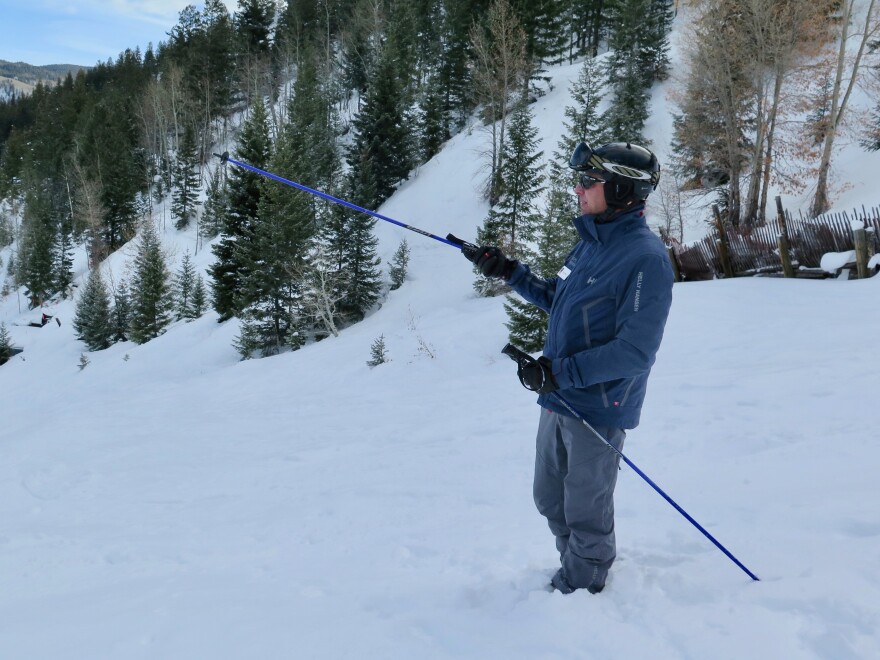Aspen Public Radio’s new reporting project Rocky Mountain Why? starts with what you’re curious about when it comes to life in the Roaring Fork Valley. Why was Aspen nicknamed Fat City? Is it true that the Roaring Fork Valley produces more potatoes than Idaho? And why is the HOV lane on the right side of Highway 82? Our news team does the digging, then shares the answers with our community.
What are you curious about? Submit your question here.

Our first question came from an anonymous listener who asked,“Is Aspen Mountain really swiss cheese underneath due to mining tunnels? Does anyone really know?”
Imagine you’re at the top of Aspen Mountain. The powder is deep, the sky is blue, and there are are snowy peaks as far as the eye can see. But under your feet, there’s over a century of mining history.
It’s been decades since people pulled silver out of Ajax on an industrial scale, but the mountain still holds plenty of reminders from Aspen’s mining heyday. To find them, you don’t have to look too far.
“It's all here in plain sight,” said Rich Burkley, vice president of mountain operations for the Aspen Skiing Company.

It’s a bluebird morning, and Burkley is taking me up and down Ajax on a hunt for remnants of its mining past. After 30 years working on the mountain, he knows it like the back of his hand.
As we tour around, I’ve got an answer pretty early on when it comes to that swiss cheese question. Burkley says throughout Colorado and around Aspen, there are tons of mine tunnels and a robust history of mining.
“On this particular mountain,” Burkley said, “it's right under you.”

Mining on Aspen Mountain started in the late 1800s and went on for decades, so the inside of the mountain got plenty carved up over the years. What’s surprising, though, is just how many reminders of the mining era are still around in 2020.
“The dumps are named after mine dumps,” Burkley said, “which is where they dumped all the ore as they were taking it out of the shafts. So if you look up right now, see that cut going up the right side of the mountain? That was the original tram from the 1890s.”
But not all of the mining on the mountain is stuck in the past. There’s one tunnel on Aspen Mountain that’s still open for mining. And after a little bit of off-piste hiking, Burkley and I wandered into it.
I talked to the owner of the mine, and for safety reasons, he’d prefer I not say where it is. But Burkley and I were able to poke our heads in the entrance, getting a glimpse into the mountain and into history.
Inside the tunnel, it’s rock walls with wooden trusses, a set of minecart tracks that disappear around a dark corner, and a ceiling low enough that you can’t help but duck.
Burkley and I can’t see past that curve, where the tracks go under a metal door that’s sealed off with chains and do not enter signs.
But he says he got a peek behind there once, back when the owners used to give tours in the early 1990s.
“You can't see the top of it and you can't see the bottom of it,” Burkley said. “You throw a rock; it takes four or five seconds for it to hit something. So it's huge.”
And that is what’s inside Aspen Mountain. Massive, cavernous rooms and miles of old tunnels. So it would be pretty fair to say that it kind of looks like swiss cheese in there. And when we got back in the gondola, I couldn’t help but ask, is it a safety risk to ski on top of all that?

“It hasn't been,” Burkley said. “But it’s certainly on my mind, and we have over the years had shafts collapse. But, so far, it has not been a safety issue, and I hope that the mountain is more or less stable.”
So it’s probably safe to ski on top of those old mine tunnels, but you shouldn’t try to wander into one. When he and I started our exploration, ski patrol was quick to arrive and make sure we didn’t get too far.
Special thanks to Anna Scott of the Aspen Historical Society for help researching this report.




